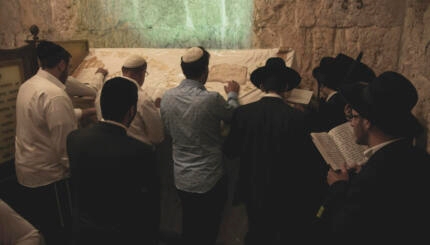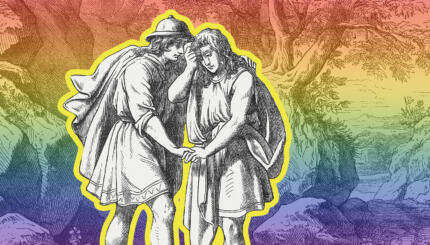The following article explores two aspects of Jewish mysticism. In the first half, the author discusses the relationship between philosophical ideas and mystical ideas. In the second half, he delineates the two fundamental concerns found in Jewish mystical literature: a claim to esoteric knowledge and the importance of certain intense religious experiences. Reprinted with permission from
“Jewish Mysticism: A Philosophical Overview,” in History of Jewish Philosophy, edited by Daniel H. Frank and Oliver Leaman, published by Routledge, a member of the Taylor & Francis Group (1996).
Of the many contributions that Gershom Scholem’s prolific
research has made to the field of Judaica, one of the most significant is the
broadening of the parameters of the intellectual history of the Jews from late
antiquity to the modern period.
This expansion of intellectual horizons is perhaps nowhere
more apparent than in the study of medieval Jewish culture, the richest period
of mystical creativity in Jewish history. Together with the more traditionally
studied forms of philosophical expression, reflecting in particular the
Aristotelian and Neoplatonic legacies transmitted to the Jews through the
Arabic translations of Greek and Syriac works, Scholem introduced a canon of
texts that approached many of the same problems in metaphysics, epistemology,
psychology, and cosmology as did the works of classical philosophy.
Mysticism and Philosophy: Discrete Disciplines
Despite the fact that Scholem was keenly aware of the
textual, philological, and historical influence of philosophical authors on
Jewish mystics in the Middle Ages, he dichotomized the intellectual currents of
mysticism and philosophy in too simplistic a fashion.
In part this has to be seen as Scholem’s reaction to his
intellectual predecessors, the nineteenth‑century German scholars of Wissenschaft des Judentums [“the
science of Judaism”], who viewed the medieval philosophical sources as the
apex of cultural creativity, whereas the mystical texts were derisively
considered to be an affront to the ethical monotheism of Judaism. Responding to
such an attitude, Scholem argued repeatedly that the mystical sources, and not
the philosophical, tapped the deepest recesses of religious consciousness by
reviving what he considered to be the long-suppressed mythical dimension of
Judaism.
To cite one representative example of this: “the old
God whom Kabbalistic gnosis opposed to the God of the philosophers proves, when
experienced in all his living richness, to be an even older and archaic
one.” The bifurcation of mysticism and philosophy led Scholem to such
distinctions as symbol versus allegory that break down under the weight of
textual detail. Ironically, in his attempt to legitimate the mystical vitality
of Judaism, Scholem reiterates the overly simplistic distinction between
rationalistic philosophy and pietistic mysticism in the Jewish Middle Ages.
Mysticism and Philosophy: Overlapping Disciplines
As an alternative to Scholem a number of scholars,
including, most significantly, Georges Vajda and Alexander Altmann, presented a
far more complex picture of the relationship of philosophy and mysticism by
demonstrating in a number of motif studies that the philosophers and mystics
utilized similar images and were influenced by the same sources.
More recent scholarship has gone beyond the comparativist
framework of Vadja and Altmann by arguing that in the lived situation of the
medieval philosophers the influence of mystical speculation is clearly
discernible. That is, it is not simply that medieval philosophers and mystics
used the same language, but that the religious context of the philosophers was
one that was saturated with mystical traditions.
Even Scholem’s
schematization of the two major currents that influenced the history of
kabbalah as Gnosticism and Neoplatonism must be qualified inasmuch as these two
strands were intertwined in the very channels that may have transmitted gnostic
myth and philosophic speculation to the kabbalists in medieval Europe. In the
telling phrase of a kabbalist active in the last decades of the thirteenth
century, Moses ben Simeon of Burgos, the mystic stands on the head of the
philosopher.
The import of this
statement is not only that the mystical tradition exceeds the bounds of
philosophical discourse, but that the former is unimaginable without the
latter. There is a great deal of truth in this comment, as it is impossible to
disentangle the threads of philosophy and mysticism when examining the texture
of medieval Jewish mysticism in any of its major expressions. This entanglement
is both historical and ideational.
Esotericism and Ecstasy: Two Distinct Concerns
It is possible to
isolate two distinct concerns running through all the major texts that scholars
include in the corpus of Jewish mysticism.
On the one hand,
there is the claim to an esoteric knowledge (whose content will naturally vary
from one period to another) that is not readily available to the masses through
the more common avenues of religious worship, ritual, or study. This knowledge
moreover, is not attained through ordinary rational or sentient means, but is
transmitted orally from master to disciple or is the result of some divine or
angelic revelation. To be sure, those enlightened in either of these ways can
then find the truths and secret meanings hidden within the traditional textual
canons of Judaism.
The former
assumption regarding oral transmission provided the key term used to designate
different forms of Jewish esotericism in the Middle Ages, namely kabbalah,
which means “tradition” or “that which is received.”
Frequently, the esoteric knowledge conveys truths about the inner workings of
the divine world and is therefore theosophical in its orientation.
The second major element identifiable in Jewish mystical
literature is the emphasis placed on the intense religious experience. The
particular form of this experience varies, but it usually includes one or more
of the following: heavenly ascent, vision of the divine form, angelification,
or mystical union. What also distinguishes the ecstatic experience is the claim
that special techniques of a meditative sort were required to induce the
desired frame of mind.
It is on account of these
techniques–especially those that involve recitation and/or combination of the
letters of divine names–that an important strand of Jewish mysticism bears a
strong resemblance to magical practices. Indeed, in some cases it is extremely
hard to draw the line between mysticism and magic within Jewish sources. Those
texts that are of an almost purely magical sort are referred to in the
traditional literature itself as practical kabbalah (qabbalah ma’asit), to be distinguished from the more theosophical
or speculative kabbalah (qabbalah
‘iyyunit).
It must be noted, however,
that important theosophical elements are often found in these more practical
texts, the study of which has been grossly neglected by scholars. Even a
cursory glance at magical charms, amulets, incantations, exorcisms, and
formulae reveals to what extent this genre of literature is indebted to various
forms of doctrinal information regarding, for example, the nature and names of
angels and demons, attributes of God, the nature of the soul, the fate of the
heavenly bodies, and so on, which are essential elements in Jewish mystical
texts as well.
One may legitimately
distinguish mysticism from magic on the basis of the stated goals of a given
source, but one must at the same time recognize the conceptual underpinning
shared by both enterprises.

Help us keep Jewish knowledge accessible to millions of people around the world.
Your donation to My Jewish Learning fuels endless journeys of Jewish discovery. With your help, My Jewish Learning can continue to provide nonstop opportunities for learning, connection and growth.


